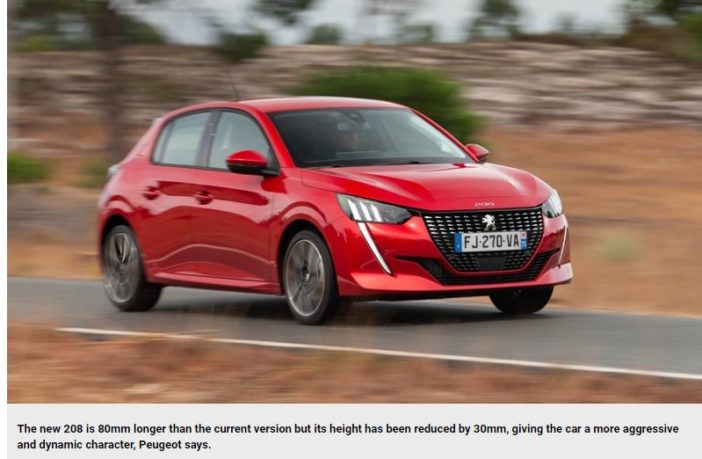Automotive News Europe
Peter Sigal
Peugeot has moved the new 208 upmarket in an effort to leapfrog competitors from Renault, Volkswagen and Ford in the small hatchback segment.
Part of a sequence of small hatchbacks that started in 1983 with the 205, the 208 retains the same model designation as the previous generation instead of being called the 209, a move that Peugeot says is intended to create a more consistent lineup. All Peugeot models now end in the number 8.
The 208 is one of the first PSA Group models on the CMP platform, which was designed to accommodate both internal combustion engines and electric powertrains. The battery-electric e-208 will be available in early 2020.
Peugeot says the new architecture helps with emissions because it is 30 kg lighter than the previous PF1 platform and has better floor pan aerodynamics.
Peugeot has simplified the internal combustion engine lineup, reducing displacement options to two from five for the outgoing car. The new 208 comes as a 1.5-liter diesel or a 1.2-liter gasoline. The 208 offers a choice of three transmissions: five- and six-speed manuals and an eight-speed automatic that can be shifted with paddles behind the steering wheel.
Certain driver assistance features are available only with the automatic. Peugeot officials say about 80 percent of buyers will opt for gasoline engines, with about 10 percent each for diesel and electric.
Dimensionally, the new 208 is 80mm longer than the current version but its height has been reduced by 30mm, giving the car a more aggressive and dynamic character, Peugeot says. The extra length is most noticeable in rear-seat legroom and kneeroom.
Peugeot designers took inspiration from the 205 GTi hot hatchback of the 1980s, most noticeably in the proportions and C pillar, when creating the new 208. Other design features include deeper body contours made possible by new stamping techniques, bolder “lion’s claw” running lights, and a black band at the rear between the taillights, a detail seen on other new Peugeot models including the 508, 3008 and 5008.
In the first half of 2019, the 208 was fourth in its segment with 124,703 sales, according to figures from JATO Dynamics, a decline of 5.5 percent from 2018. The Renault Clio led the segment (185,517) followed by the Volkswagen Polo (146,344) and Ford Fiesta (125,795). Another key rival is the new Corsa from Peugeot sister brand Opel. Also the Corsa is also underpinned by the CMP architecture.
IHS Markit forecasts Peugeot will produce about 266,000 208s in 2020 in Slovakia and Morocco. Last year Peugeot sold about 295,000 208s worldwide, with Europe accounting for 230,000 units.
The small car segment, Europe’s largest and most competitive, has been in decline as buyers switch to SUVs and crossovers. In the first half of the year 1.57 million small cars were sold, down 6.4 percent from the first six months of 2018.Fast Facts
Launch date: October 2019
Base price: 15,500 euros (France)
Where built: Trnava, Slovakia; Kenitra, Morocco
Main rivals: Renault Clio, VW Polo, Ford Fiesta, Opel Corsa
Powertrain: The 208’s engine range includes a 1.2-liter, three-cylinder gasoline unit offered with 75 hp, 100 hp and 130 hp and a 1.5-liter, four-cylinder diesel with 100 hp. The diesel is expected to be popular with fleet buyers while the 100-hp gasoline variant is expected to be the car’s top-seller.
Safety: Depending on trim level, driver assistance and safety equipment includes lane keeping, adaptive cruise control and parking assistance, driver-attention monitoring, automatic headlight dimming and blind-spot monitoring with course correction.
3D display: Upper-trim models have a holographic 3-D instrument display that prioritizes safety warnings and essential information. The display is customizable, allowing drivers to select the information they will see first.







